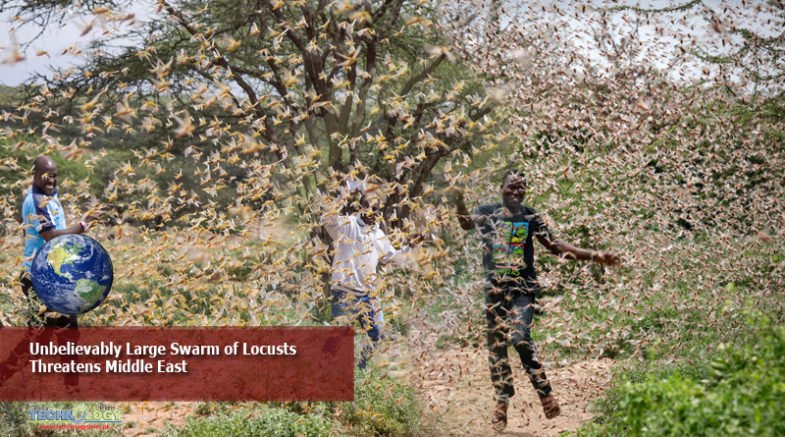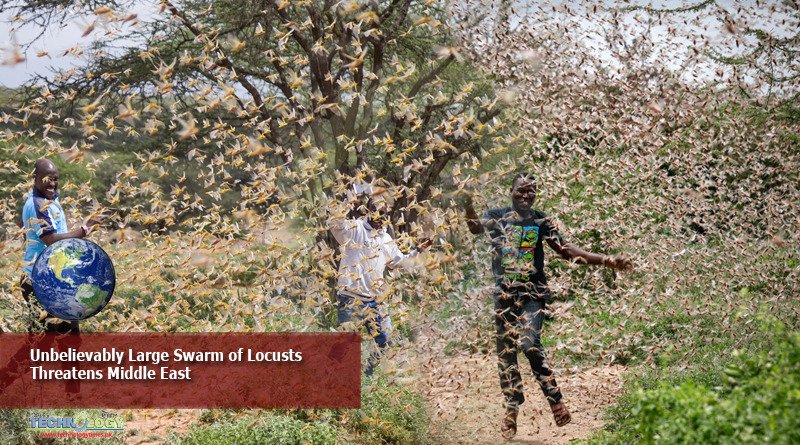A locust plague that’s been growing in the Horn of Africa this month is slated to make its way across Northern Africa and the Middle East, the likes of which have been unseen in the region for over 30 years.

In the last month, the locusts have devastated crops in Kenya, Ethiopia and Somalia, and the swarm is still breeding.
Locust plagues destroy crops and cause major agricultural devastation. This leads to famine and starvation, which in turn can kill populations.
Locusts in Kenya, Ethiopia and Somalia have been breeding at an unprecedented rate. This represents “an unprecedented threat to food security and livelihoods at the beginning of the upcoming cropping season,” according to Locust Watch, a monitoring division of the United Nations Food and Agriculture Organization, which provides emergency assistance to countries facing desert locust invasions.
The locust plague is already the worst in Kenya in 70 years, and in at least 25 years for other parts of the region. The swarms can move up to 90 miles a day, and can eat their weight daily. The current swarm eats as much as 35,000 humans a day would consume. The locust swarm strips all vegetation in their path, threatening the food supply for millions of people.
The desert locust threatening the region “is the most destructive migratory pest in the world,” according to the Locust Watch website.
Experts say that the swarm is projected to go as far east as Pakistan in the coming months. It will begin descending upon the Middle East in the next month, coinciding with the Jewish holiday of Passover, which celebrates, among other things, the Biblical 10 plagues in Egypt, one of which was locusts.
There are setbacks to the locust management plans. Aerial spraying is the most effective way to stop locusts, but aid agencies say there is not enough equipment or funding to adequately beat down the swarms.
The setbacks are being exacerbated by the global actions taken to curb the spread of COVID-19. Experts can no longer travel to in-country meetings to train locals to comb at the locust threat, according to Rome-based Senior Locust Forecasting Officer Keith Cressman on Monday.
Cressman, who has worked with the organization for over three decades, told The Times of Israel on Monday that the previous time the region has been in such danger was during the plague of 1987-1989.
“Studies have linked a hotter climate to more damaging locust swarms, leaving Africa disproportionately affected— 20 of the fastest warming countries globally are in Africa,” Richard Munang, United Nations Environment Programme expert on climate and Africa, said in a recent interview. “Wet weather also favors multiplication of locusts. Widespread, above-average rain that pounded the Horn of Africa from October to December 2019 were up to 400% above normal rainfall amount.”
The heavy rains were spurred by a cyclic shift in sea surface temperatures called the Indian Ocean Dipole, also known as the ‘El Niño of the Indian Ocean.’ The pattern also led to a record level of tropical cyclone activity in the North Indian Ocean, which some researchers have linked to climate change.
“While climate change is a global phenomenon, Africa stands out for its vulnerability which is driven primarily by the prevailing low levels of socioeconomic development,” Munang said. “Persons living in poverty face compounding vulnerabilities to climate change impacts because they lack the resources to quickly recover from its effects. In this case, desert locusts are ravaging crops in the field before harvesting, wiping out livestock and wildlife feed, and with them savings, assets and livelihoods.”
Courtesy: The Weather Channel
